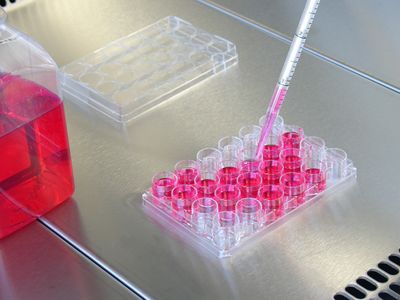ABOVE: JEFF FUSCO AND HOWARD HUGHES MEDICAL INSTITUTE (HHMI)
Growing up in a small town in Illinois, Chantell Evans recalls spending much of her time gazing up at the skies, searching for constellations, or down at the ground, picking out new rocks for her collection. At school, she gravitated toward science, enrolling in a bachelor’s program in chemistry at Southern Illinois University in 2005. It was here, earning extra money by organizing lab equipment, that she got her first real glimpse of research. In a world beyond the pH tests and titrations of her early chemistry classes, Evans watched scientists in the labs using sophisticated technology to chip away at life’s unknowns.
Keen to become part of this world, Evans began a PhD in molecular and cellular pharmacology at the University of Wisconsin–Madison in 2009. She joined the lab of neuroscientist Edwin Chapman, where she investigated synaptic vesicle exocytosis, a signaling process in neurons that is mediated by influxes of calcium ions. To demonstrate that the speed of synaptic transmission depends on a protein called synaptotagmin 1 (syt 1), Evans engineered a version that interacts with the neuronal membrane for longer, enabling her to untangle syt 1’s impact on vesicle exocytosis.
Evans took the syt 1 backbone and grafted on loops from other naturally occurring, slower-acting forms of synaptotagmin, assembling an enormous panel of chimeras. It was a challenging protocol, Chapman tells The Scientist, and yet “she was a natural.” Compared to the normal protein, Evans’s chimeras prolonged neurotransmitter release, demonstrating that syt 1 determines the time course of synaptic transmission.
According to Chapman, Evans became a “lab leader” in other complex techniques too, including isothermal titration calorimetry, fluorescence labeling, and spectroscopy. When it came time for a postdoc, Evans says she was eager to tackle skills missing from her repertoire. She was drawn to University of Pennsylvania cell biologist Erika Holzbaur, whose group was using live-cell imaging to spy on cellular organelles in real time. Evans arrived in 2016, focusing on mitophagy—the targeted degradation of damaged mitochondria—and its role in neurodegenerative disease. The dynamic nature of the organelles made the research interesting from a technical perspective, says Evans, and investigating their role in neurodegeneration gave the project purpose.

Previous cell culture work by Holzbaur’s group had revealed how optineurin, a protein associated with amyotrophic lateral sclerosis (ALS), is recruited to damaged mitochondria as part of the PINK1/Parkin signaling pathway. Mutations in both PINK1 and PARK2, genes that encode components of this pathway, are also known to cause Parkinson’s, supporting the idea that mitochondrial dysregulation may be a common feature of neurodegenerative diseases. The PINK1/Parkin pathway had been investigated in a nonneuronal cell line, but Evans knew it needed to be explored in neurons.
She set about establishing a protocol to induce mitochondrial stress in cultured hippocampal neurons, improving on previous methods that were inconsistent or produced unrealistic levels of damage. “She was very successful in identifying simple conditions that work consistently and give mild damage,” says Holzbaur. “It was a huge step forward.”
Live-cell imaging confirmed that optineurin is recruited to mitochondria in response to stress, and revealed how damaged mitochondria stick around for an unexpectedly long time, lingering within autophagosomes for more than 24 hours. These findings offered a clue to mitophagy’s links with neurodegeneration: Natural aging or mutations in mitophagy proteins may delay an already sluggish cleanup process, leading to a buildup of damaged mitochondria that leads to neuronal death.
It was during her postdoc that Evans was awarded a highly competitive Hanna H. Gray fellowship, including $1.4 million in funding. As part of her application, Evans was asked to write a long-term proposal, which forced her to take a future-focused perspective early in her research career. “It really allowed me to take a big step back from my project and say, ‘If you could run a lab, what would you want to do?’ It helped me to start thinking about those things way earlier than maybe a lot of other postdocs would have.”
In 2021, she launched her own lab at Duke University, where she continues to probe mitophagy in the brain. Evans has assembled a team of scientists from diverse backgrounds, not only in terms of ethnic or religious identity, but with different thinking styles too, she says. Her group today includes a cell biologist, a neuroscientist, and an ecologist, each “coming with their own unique experiences” to answer the same question from different perspectives.







